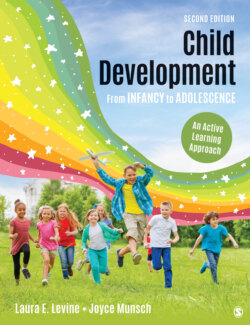Читать книгу Child Development From Infancy to Adolescence - Laura E. Levine - Страница 232
Illegal Drugs
ОглавлениеConducting research on the effect of illegal drugs on a human pregnancy is challenging because it is difficult to get mothers who are using illegal substances to provide accurate information about the amount or type of drugs they use, or the length of time they have used them. It is also hard to disentangle the effect of the drugs themselves from the effect of other factors that might damage the pregnancy. For instance, a woman who is using marijuana may also be a heavy cigarette smoker. Women who are using illegal drugs may be less likely to see a doctor during their pregnancy and are less likely to take good care of themselves in other ways. We cannot review here all the illegal substances that might be used by a pregnant woman but we briefly look at research that has been done on two of the more commonly used substances: cocaine and marijuana.
The well-documented effects of cocaine use include complications during the pregnancy itself and an increased probability of the infant being born prematurely, at low birth weight, or small-for-gestational age (Forray & Foster, 2015; Ross, Graham, Money, & Stanwood, 2015). The effect on other developmental outcomes, including cognitive, motor, and language development, has been inconsistent. Some studies report significant effects, but others report no or only small effects (Forray & Foster, 2015). It is likely that differences that mitigate or worsen effects of the prenatal exposure to the drug, such as the quality of the infant and child’s living environment, are responsible for this variability. Although prenatal exposure to cocaine has not consistently been associated with lower overall cognitive ability, research continues to examine the impact on more subtle aspects of cognitive functioning in later childhood and adolescence, including impairment in attention, working memory, information processing, and problem-solving skills (Ross et al., 2015).
The psychoactive ingredient in marijuana crosses the placenta barrier during pregnancy and enters the bloodstream of the fetus, where it can result in stunted physical growth and decreased birth weight (Ross et al., 2015). After birth, prenatal exposure to marijuana has been associated with learning disabilities and memory impairment in young children; impulsivity, hyperactivity, inattention, and poor problem-solving skills in school-age children; and hyperactivity, inattention, and lack of self-control and emotional regulation in adolescents (Ross et al., 2015; Wu, Jew, & Lu, 2011). A possible explanation for these findings is that cannabis alters the neurology in the prefrontal cortex, the site in the brain responsible for higher cognitive functioning that develops later in childhood (Huizink & Mulder, 2006). Prenatal exposure also may change brain circuits in ways that make the rewarding effect of the drug even stronger. This idea is supported by several longitudinal studies that have found that prenatal maternal use of marijuana predicted the likelihood of adolescents beginning to use the drug themselves (Porath & Fried, 2005; see also Jutras-Aswad, DiNieri, Harkany, & Hurd, 2009), lowered the age at which they began using, and increased the frequency of use (Day, Goldschmidt, & Thomas, 2006). Despite the number of negative developmental outcomes that have been associated with maternal use of marijuana, our current research may actually underestimate the long-term effects of the drug on children because the concentration of the active compound in marijuana today is much higher than when many earlier studies were done.
T/F #6
Children who were exposed to marijuana prenatally are more likely to smoke marijuana when they become teenagers. True
Although marijuana has been legalized for recreational or medicinal use in some states, and although there are some recognized medical uses for it, the American Congress of Obstetricians and Gynecologists (2015) recommends that doctors ask pregnant women about their use of marijuana when asking about their use of alcohol and tobacco and urge them to discontinue its use while pregnant and nursing. For marijuana sold through legitimate channels, the American Medical Association (2016) has called for point-of-sale warning labels on marijuana, similar to those used on alcoholic beverages and tobacco products, to warn pregnant women about the risk of using the product.
A pregnancy offers a woman the opportunity to decrease or even discontinue her substance use, but similar to the situation with smoking, many resume use following the birth of their infant (Bailey, Hill, Hawkins, Catalano, & Abbott, 2008; Koniak-Griffin, Spears, & Stein, 2010), with the youngest mothers being the ones who are more likely to resume using (De Genna, Cornelius, Goldschmidt, & Day, 2015). Returning to using marijuana is a concern because the active compound in cannabis is present in breast milk, so the infant’s developing brain is further exposed to this substance. As you will learn in Chapter 15, young people increasingly do not see this drug as harmful, which means that in the future children with a possible neurological sensitivity to marijuana because of their prenatal exposure may also have parental role models who engage in this behavior. Women need to think carefully about these consequences before using recreational drugs.
A study that compared the independent effects of alcohol, tobacco, cocaine, and marijuana on the likelihood of a preterm delivery or restricted fetal growth concluded that the legal substances, alcohol and tobacco, were more harmful than the illegal ones (Janisse, Bailey, Ager, & Sokol, 2014). This research serves as a reminder that the legal-illegal distinction should not be equated with the harmfulness of a substance. Figure 4.6 summarizes some of the outcomes of drug and alcohol use.
Description
Figure 4.6 Effects of prenatal drug exposure.
Source: Ross, E. J., Graham, D. L., Money, K. M., & Stanwood, G. D. (2015). Developmental Consequences of Fetal Exposure to Drugs: What We Know and What We Still Must Learn. Neuropsychopharmacology, 40(1), 61–87. Reprinted with permission from Macmillan Publishers, Ltd.
